Digital Dashboard Helps Everyone Find Accessible Climate Solutions in Georgia
Sep 04, 2025 —
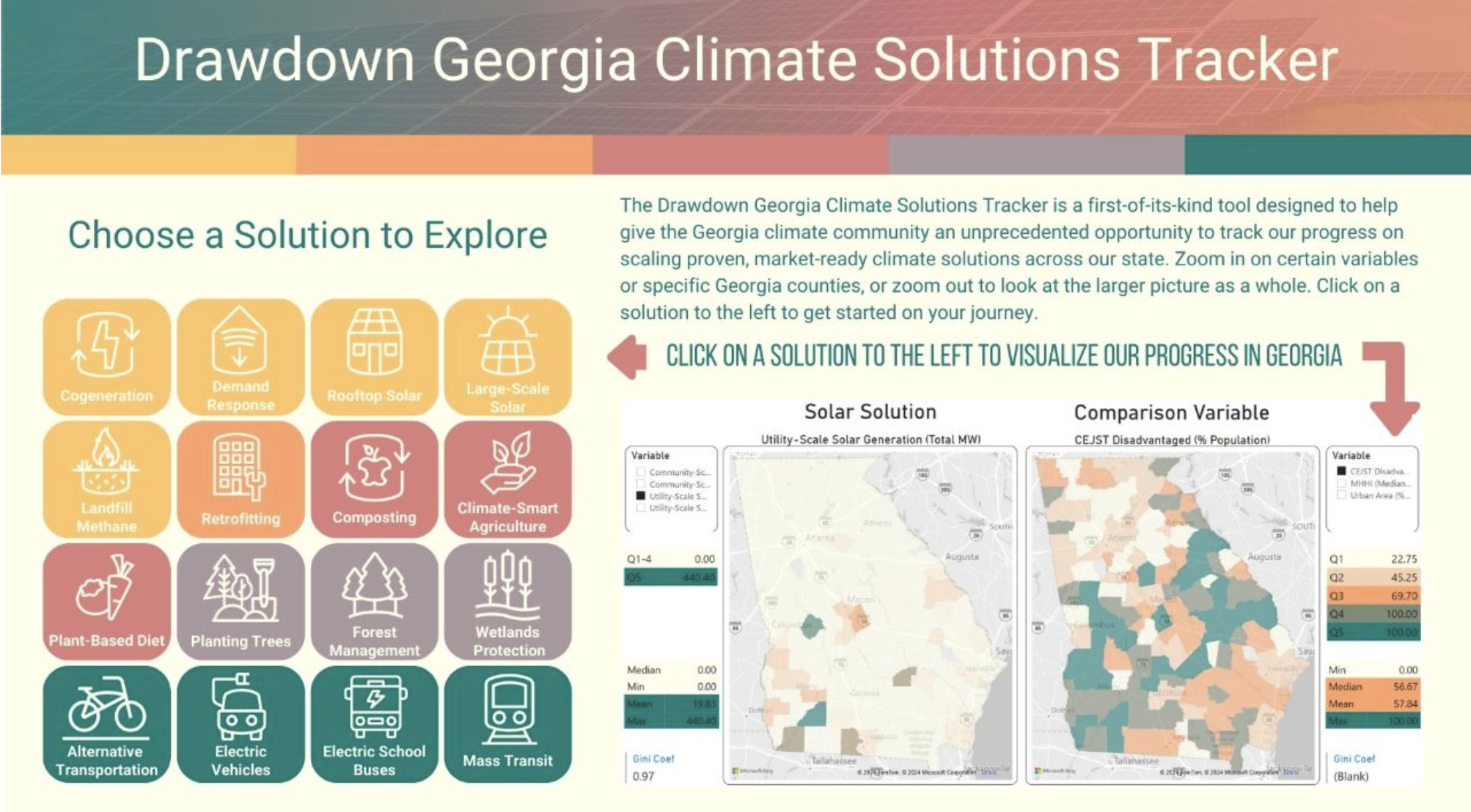
Electric vehicles. Rooftop solar. Cycling to work. Knowing where to start when reducing your personal carbon footprint can be daunting. But a new tool from Georgia Tech makes it easier for anyone to figure out how they can help address climate change.
The Drawdown Georgia Solutions Tracker is a digital dashboard that enables everyday Georgians to see how effective various technologies could be for each county. The tracker analyzes public data for 16 solutions — from planting trees to public transit — that can lower greenhouse gas emissions. The tracker is equally essential for policymakers and business leaders, enabling them to identify opportunities to propose legislation or adjust operations to reduce carbon emissions.
To use the tracker, viewers click on a solution to see its impact. Then, they specify a particular county, and the data is tailored to the most relevant metric. For example, if someone picks “plant-based diet” as a solution, they can see how many vegan restaurants are already in their county. The tracker also contrasts the climate solution with a relevant area that might benefit if the solution is implemented. For the plant-based example, the tracker compares it to urban density.
This tracker is one of the many initiatives of Drawdown Georgia, one of the Ray C. Anderson Foundation’s key funding initiatives based on research conducted by Georgia Tech, Georgia State University, the University of Georgia, and Emory University. Drawdown Georgia's goal is to reduce Georgia’s carbon impact by 57% by 2030 and to accelerate Georgia’s progress toward net-zero greenhouse emissions.
Drawdown Georgia also developed a carbon emissions tracker that shows carbon emission levels by county. The dashboard was a success, but the Drawdown Georgia team wanted to create a more proactive tool. The Solutions Tracker was designed so that anyone could make smalldaily changes to improve the climate — not just track it.
“We began the Drawdown Georgia project with the goal of cutting state pollution significantly,” said Marilyn Brown, Regents' Professor and the Brook Byers Professor of Sustainable Systems in the Jimmy and Rosalynn Carter School of Public Policy. "To get Georgians involved, we decided to focus on local and regional opportunities to reduce emissions.”
Drawdown Data
The data combines federal and state sources from the U.S. Energy Information Administration, the National Renewable Energy Laboratory, and the Department of Agriculture. Some solutions may seem obvious, like planting trees, but others are more niche. For example, decomposing trash often produces methane gas, which means that landfills contribute to greenhouse gas emissions — important information for policymakers to consider when developing carbon reduction strategies.
The researchers hope everyone will use the tracker. Politicians and policymakers can find new ideas for legislation or the adoption of these solutions. Business leaders can find opportunities to hit their decarbonization goals. Georgians can use the tracker to figure out which solutions are most sustainable for their lives. Even scientists can learn which methods to home in on for their research. Since the tracker is available via Creative Commons, anyone can use the data to build their own tools or models.
The tracker is already having a real-world impact. Brown and the Drawdown Georgia team have collaborated with the state of Georgia and the 29-county metro Atlanta area on their carbon action plans. They’ve also partnered with 75 businesses on carbon action plans and other solutions through the Drawdown Georgia Business Compact, managed by the Ray C. Anderson Center for Sustainable Business in the Scheller College of Business. As these stakeholders ask questions about different climate solution impacts, the team has expanded the tracker accordingly. They’ve also recently redesigned the user interface to make it even more accessible for everyday users.
From improved public health to business opportunities, the state requires reduced greenhouse gases, and Georgia Tech is not only tracking emissions but helping to fix the problem, too.
Tess Malone, Senior Research Writer/Editor
tess.malone@gatech.edu
Rampi Ramprasad Awarded $2 Million Grant to Pioneer AI-Driven Recyclable Packaging Materials Design
Sep 04, 2025 — Atlanta, GA
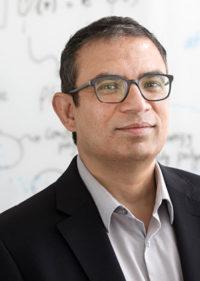
Rampi Ramprasad
The National Science Foundation (NSF) has awarded School of Materials Science and Engineering (MSE) Professor & Regents’ Entrepreneur Rampi Ramprasad a $2 million grant to advance research at the intersection of artificial intelligence (AI) and polymer science. He and a multidisciplinary team of Georgia Tech researchers will design next-generation polymer-based packaging materials that can easily be recycled or biodegraded at the end of their use. The project addresses one of the most pressing challenges in global sustainability: plastic waste.
Read more on the Georgia Tech Materials Science and Engineering Newspage
Georgia Tech Permaculture Interest Group
Come to the first meeting of the semester of the Georgia Tech Permaculture Interest Group to get a healthy dose of optimism and empowerment. It is open to everyone in the Georgia Tech community – students, staff, faculty, alumni, and administration, whether you are brand new to permaculture, or a certified practitioner.
[Wikipedia definition of "Permaculture." Note: Many think this definition is incomplete and oversimplified.]
Farming for the Future of the Planet: How Liming Could Be Key for Carbon Removal
Aug 19, 2025 —

A tractor applying lime to mitigate acidity in the soil. [Adobe Stock]
Overly acidic soils can mean the difference between feeding a region and famine. Each crop needs the right soil pH to thrive, and acidic conditions, produced primarily by industrial emissions and application of fertilizers, can harm growing conditions. It has recently been estimated that sub-Saharan Africa, for example, loses billions of dollars annually in crop yield because of poor agricultural conditions. But there is a possible solution — and it could even help the Earth’s climate.
For centuries, farmers have neutralized soil acidity with a practice called liming. It involves mixing crushed calcium- or magnesium-rich rocks, known as limestone, into the soil to balance pH. But liming has long been an assumed tradeoff in which removing acid also meant increasing carbon emissions into the atmosphere.
New research from Georgia Tech shows that the opposite may be true. Agricultural liming can actually reduce atmospheric carbon dioxide and improve crop yield.
“The current thinking about liming is that farmers must choose between doing something that could benefit them economically or reducing their greenhouse gas emissions,” said Chris Reinhard, an associate professor in the School of Earth and Atmospheric Sciences. “But this is often a false choice. They can do both.”
The researchers published a new framework for the potential role of liming in food security and greenhouse gas mitigation in August in the paper, “Using Carbonates for Carbon Removal,” in Nature Water.
Collecting Carbon Data
The framework is based in part on ongoing work Reinhard and his collaborators are pursuing on the impacts of agricultural liming in the Upper Midwest’s Corn Belt for a Department of Energy study. With funding from the Grantham Foundation, they’re now turning their attention to local farms in southern Georgia and North Carolina.
For each farm, the researchers measure data that most farmers would collect already, like soil pH and nutrients. But the team also tracks more specialized measurements, including trace elements and greenhouse gas fluxes in the soil. All this data is matched to a high-resolution, machine learning grid of the farm’s geography to determine exactly which crops might benefit.
The researchers are using the data to build a computer model that predicts how carbon dioxide and other greenhouse gases will move through any particular soil system. Liming won’t universally absorb carbon dioxide — or if it does, there may be an occasional time delay between carbon emissions and absorption — which is why the researchers factor soil, crop rotation, climate, and other management practices into their calculations.
“Our goal is to develop a way that farmers can monitor and plan cheaply, and largely through techniques they are already using, so we don't have to send out a whole team to gather data,” Reinhard said. “We are trying to develop a predictive model architecture for planning agricultural practice across scales, but it’s important that the techniques required on the field are actually feasible for farmers.”
This data could be pivotal for farmers, and it could also help policymakers as they address farming subsidies and foreign aid funding. Globally, food-insecure regions like sub-Saharan Africa could become more self-sufficient with more liming. Farmers in parts of the U.S. could also improve their yields and, in effect, their profits, if they limed more fields.
The added benefit of lowering carbon could get even more farmers on board, and there is extensive exploration and implementation of agricultural practices already on voluntary and governmental carbon markets. Carbon dioxide is only one greenhouse gas that liming can lower; researchers are also exploring how liming can reduce methane and nitrous oxide — the latter of which is a key climate impact of human agriculture and is often considered a “hard-to-abate” emission.
Liming may be a centuries-old practice, but its applications are potentially much wider than initially believed. In the future, farming may be part of the answer to reducing carbon emissions, instead of part of the problem.
Tess Malone, Senior Research Writer/Editor
tess.malone@gatech.edu
Forest Expansion Increases Agricultural Output, New Study Shows
Aug 19, 2025 — Atlanta, GA

Agriculture is the largest cause of deforestation. So, it follows that forest expansion efforts would displace agriculture — but new research from Georgia Tech's School of Economics reports that that’s not necessarily the case. And not only that, forest expansion actually increased agricultural output in the study.
These findings can help governments, policymakers, and conservation organizations more accurately assess the costs and benefits of forest expansion projects in the fight against climate change.
“The key policy implication is that there may be co-benefits to using forest expansion as a tool to sequester carbon,” said Matthew E. Oliver, associate professor at the School of Economics and co-author on the paper. Without accounting for them, the net social benefits may be significantly underestimated, the researchers write.
The findings could also suggest alternative paths for aid organizations, Oliver said.
“Development programs don’t have to be in the form of direct aid. This project was about increasing forest areas, but it also supported the local economy in another indirect way.”
Main Findings
The paper, written by Oliver and Dylan Brewer at Georgia Tech and Vikrant K. Kamble at Muskingum University, was published in Land Economics. The project began as Kamble’s Ph.D. dissertation, on which Oliver and Brewer co-advised. They find:
- Following one of the largest forest expansion programs in Rajasthan, India, agricultural production in the area increased by 24% in the seven to 14 years after planting.
- The researchers hypothesize this could be due to increased pollinator activity in the newly forested areas and the 2% increase in rainfall they measured.
- While the 2% increase is statistically insignificant, yields for crops relying on rainfall grew considerably while yields for crops relying on irrigation did not, suggesting a connection between forest expansion, rainfall, and improved agricultural outputs.
This is some of the first evidence of its kind, and the researchers caution that the results may not hold true everywhere.
However, “our task was to rule out a negative impact on agriculture, and the fact that we're not seeing that and that there could be a positive impact is really strong evidence that we don't see a reverse trade-off,” Brewer said. “When you go back and reforest, it's not going to eat into agricultural resources.”
“Is There a Tradeoff between Forest Expansion and Agriculture?” was published in Land Economics in August 2025. Read more at https://doi.org/10.3368/le.101.3.022924-0020R
Ivan Allen College of Liberal Arts
Georgia Tech Summer Interns Building Community Capacity
Aug 15, 2025 — Atlanta, GA
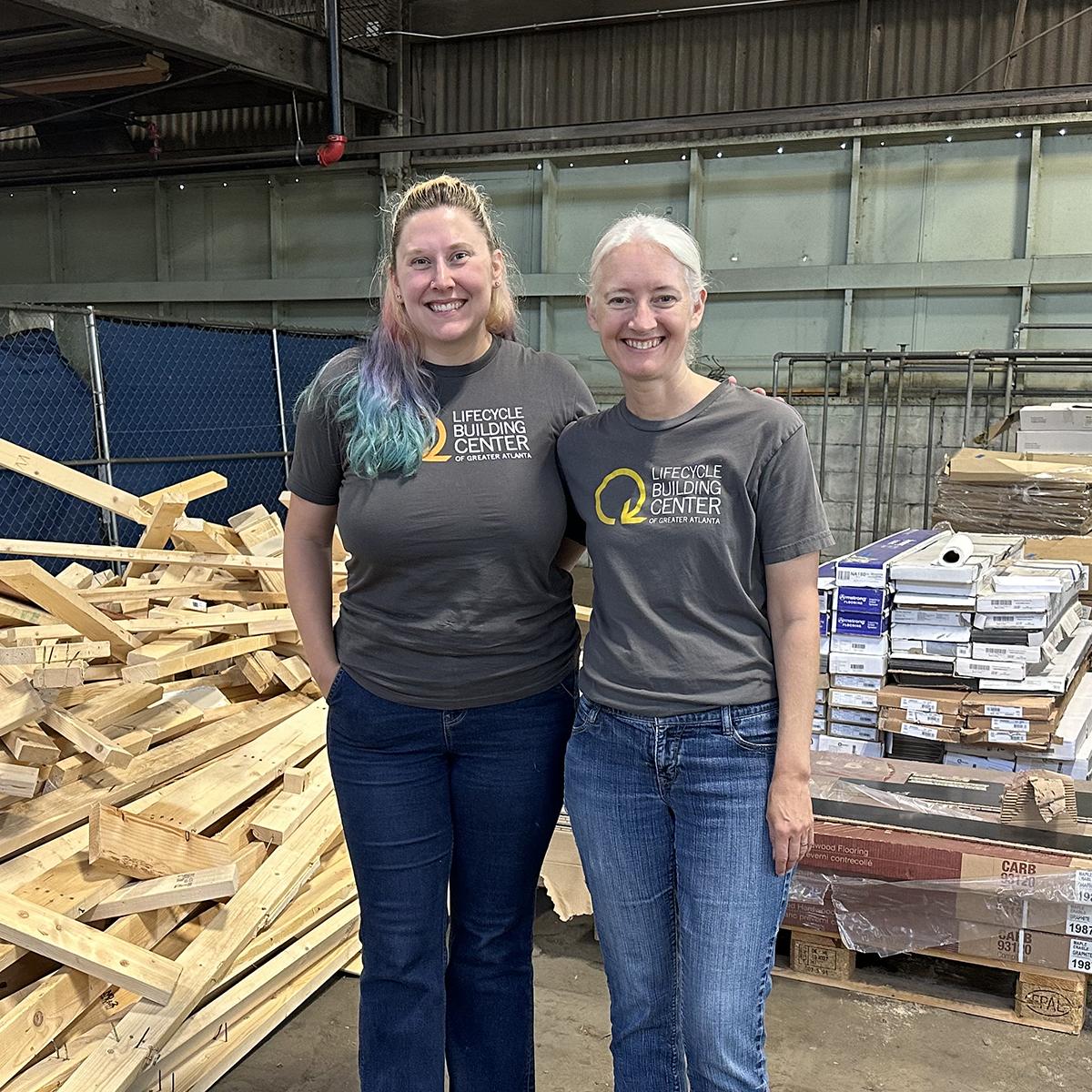
Georgia Tech intern Morgan Hale and Lifecyle Building Center Executive Director Shannon Goodman
Every summer for the last eight years, Georgia Tech students, from engineering and computer science to sustainable energy and environmental management, have lent their talents and creative energy to metro Atlanta sustainability-oriented organizations to increase their capacity in the community.
The Sustainable Communities Summer Internship Program in the Center for Sustainable Communities Research and Education (SCoRE) taps students from across the Institute, who gain real-world experience in both sustainability and community engagement, while participating partners scale their operations and deepen their relationship with Georgia Tech.
“It is a nontraditional internship, but it is so effective,” says Kristina Chatfield, director of business administration for the Brook Byers Institute for Sustainable Systems (BBISS), who manages the operational components of the program.
Impact on Atlanta’s Sustainability Community
Now in its eighth summer, the program has placed more than 200 students with over 60 Atlanta community organizations. Many return year after year, like WunderGrubs, an Atlanta-based insect farm that wants to bring a sustainable, nutritious form of protein to communities.
“I can’t overstate the value that Georgia Tech students bring to our company every summer through the SCoRE internship program,” says CEO and co-founder Akissi Stokes-Nelson, explaining that WunderGrubs’ mission is rooted in food equity and social impact. “We’re constantly innovating to support smallholder farmers, develop educational programs, and expand our reach both locally and globally. The SCoRE interns have been instrumental in helping us realize this vision.”
Stokes-Nelson says they add immediate capacity to WunderGrubs’ small team, bringing fresh perspectives and technical expertise — whether it’s developing new curricula for STEAM summer camps, introducing technology like Internet of Things (IoT) sensors and Arduino controllers, or helping the company build and scale its modular “grub shed” farming systems. She credits them with enabling her to reframe her business, pilot new programs, and even expand internationally, citing a recent partnership in Rwanda.
“What sets the Georgia Tech interns apart is their maturity, technical skill, and genuine passion for social impact. They’re not just here to learn — they’re here to contribute, innovate, and help us grow,” she says.
“The program is unique in its focus on both student development and organizational impact, particularly for underrepresented and first-generation students,” says Ruthie Yow, associate director of SCoRE, who leads partner engagement and student learning.
Georgia Tech covers all costs, including stipends for the full 12 weeks. Students take part in a seminar one evening a week to learn about grassroots sustainability innovation. They can also earn an internship course credit.
Connecting With Students in STEM
Intern Ridoine Idrissou, a computer science undergraduate at Tech, supported WunderGrubs’ “Tech Avengers” STEM summer camp. “We taught kids about cybersecurity, IoT, how to be safe online, and they learned about mealworms. They got rid of almost one ton of trash,” recalls Idrissou, who also developed IoT kits for the company’s farm sheds. “It’s not all about coding,” adds the Togo, West Africa, native. “It’s about connecting to the environment. It’s given me a whole different type of experience than I normally have as a computer science major.”
Idrissou, who has spent his last three summers interning, credits the program with giving him a chance when nobody else would. “My internship experience makes me appreciate the field I’m in, and it gives me a good idea of how to be mindful, when building software or other products, of the well-being of other people.” He plans to pursue a career in cybersecurity and system administration after he graduates next spring.
This positive internship experience isn’t the only one. Another organization benefiting from Georgia Tech’s talented students is the Lifecycle Building Center (LBC) in Atlanta.
Shannon Goodman, a Georgia Tech architecture program alumna, serves as executive director of the LBC. She considers her interns foundational to her nonprofit, which reduces waste in the built environment by salvaging materials like lumber, cabinets, flooring, and appliances, and making them available to the community, nonprofits, and for reuse in new projects. The organization runs a 70,000 square-foot warehouse and provides free materials and services to nonprofits across Atlanta.
“Our interns have been the connective tissue that helps all the different resource-constrained CEOs and community-based organizations build strong, trusted relationships with each other and lay the groundwork for our training program,” Goodman says.
Assessing the Lifecycle of Salvaged Building Materials
Morgan Hale interned at LBC while completing her graduate degree in sustainable energy and environmental management. “This internship program bridges sustainability with all the academic pathways at Georgia Tech. It does a great job of engaging students and educating them on ways to take what they're learning from school and map that into a career in sustainability,” says Hale, whose capstone project focused on the lifecycle assessment of salvaged building materials. “This internship perfectly aligned with my academic and career interests in sustainability and policy,” she adds. “And the extra workshops and networking opportunities are invaluable.”
For Goodman, education remains a key part of her team’s role. “Our job at the end of the day is helping people understand all the different types of opportunities that get lost when we just throw materials away. I don't know how we would do it without our interns. Through her capstone project, Morgan developed tools and procedures for calculating the embodied carbon and GHG emissions of the materials we salvage to create Environmental Product Declarations, or EPDs, for reclaimed materials, which don’t currently exist in the U.S. EPDs allow us to prove exactly how much better salvaged materials perform compared to new products, and will enable the material reuse industry to scale in the U.S. at a rate never seen before.”
LBC’s connection to Georgia Tech doesn’t stop with the internship program, however. “We have had countless professors from different departments of Georgia Tech bring their students here to learn about what we do, engage with us, and get materials from us,” says Goodman, noting that back in 2022, Georgia Tech was instrumental in helping her assemble community organizations like the West Atlanta Watershed Alliance and many others to form the ReBuildATL Coalition. Today, the coalition includes more than 40 nonprofits, academic institutions, industry partners, and local government agencies that empower Westside Atlanta neighborhoods.
Learn More
The Sustainable Communities Summer Internship Program is a partnership between SCoRE and the Office of Community-Based Learning. It is co-sponsored by the Brook Byers Institute for Sustainable Systems, the Strategic Energy Institute, the Renewable Bioproducts Institute, the Office of Commercialization, and the Sustainability Next initiative.
To learn more about the program, including how to contribute financially to the program or to become a participating partner, visit https://scre.research.gatech.edu/sustainable-communities-summer-internship-program.
By Anne Wainscott-Sargent

Left to right: Nathanael Sancinito, Akissi Stokes-Nelson, and Ridoine Idrissou at the SCoRE internship closing session.
Brent Verrill, Research Program Communications Manager, BBISS
Seashells Inspire a Better Way to Recycle Plastic
Aug 13, 2025 — Atlanta, GA
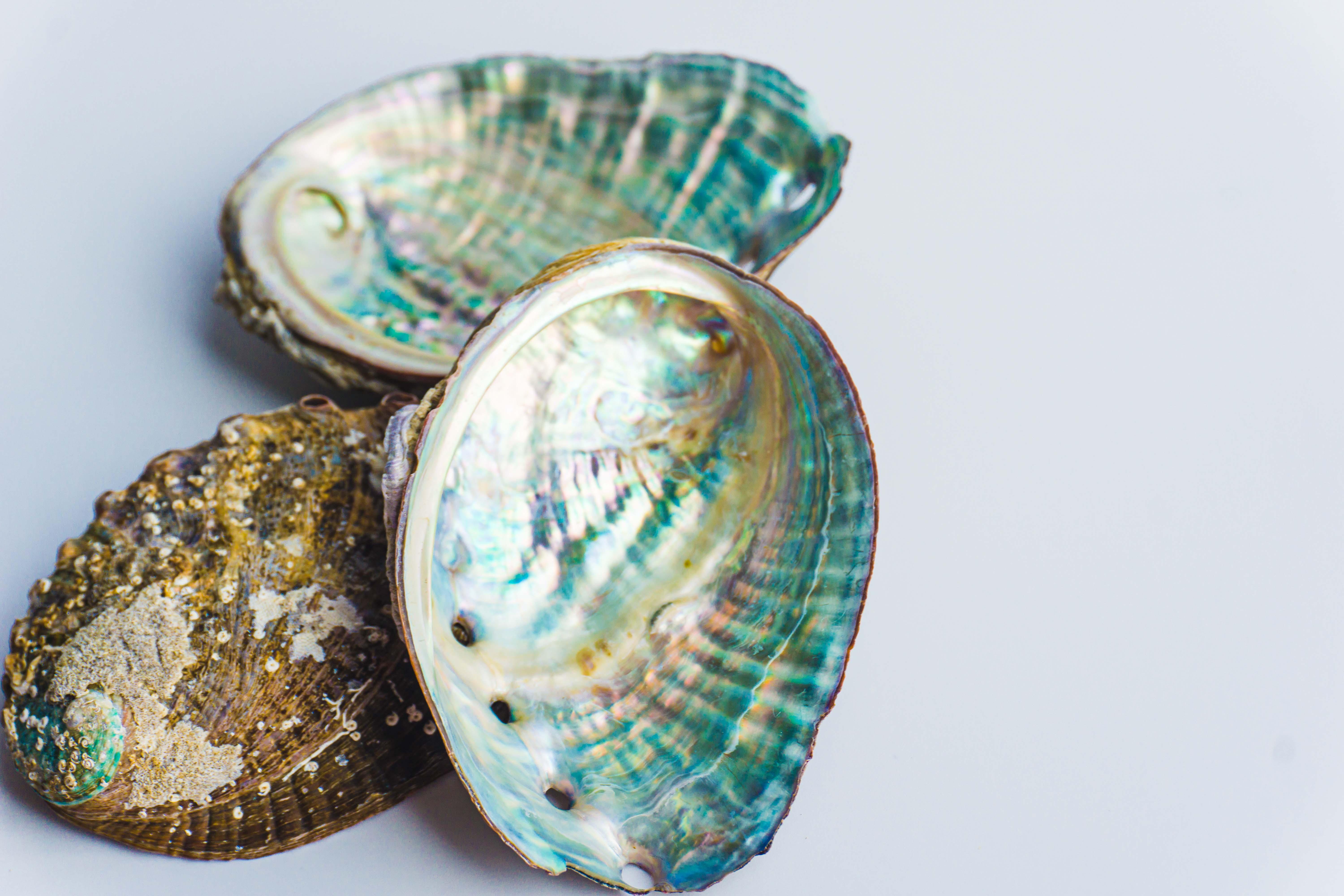
Researchers from Georgia Tech have created a material inspired by seashells to help improve the process of recycling plastics and make the resulting material more reliable.
The structures they created greatly reduced the variability of mechanical properties typically found in recycled plastic. Their product also maintained the performance of the original plastic materials.
The researchers said their bio-inspired design could help cut manufacturing costs of virgin packaging materials by nearly 50% and offer potential savings of hundreds of millions of dollars. And, because less than 10% of the 350 million tons of plastics produced each year is effectively recycled, the Georgia Tech approach could keep more plastic out of landfills.
Aerospace engineering assistant professor Christos Athanasiou led the study, which was published in the journal Proceedings of the National Academy of Sciences (PNAS).
Read the Q&A of the findings, and see a video of the testing, on the College of Engineering website.
Jason Maderer
College of Engineering
maderer@gatech.edu
Sustainability Fellows and Ambassadors Information Session
Interested in the Sustainability Fellows or Ambassadors programs? We'll give an overview and answer all your questions about participation in this info session!
Meet with a panel of past Sustainability Fellows and Ambassadors to learn from their experience and ask questions!
OUR PANEL:
Fellows
GT Sustainability Network Fall 25 Kick-Off
This month’s meeting is organized by the Sustainability Network Executive Committee. RSVP at https://forms.cloud.microsoft/r/HHquMrd7yn
Join us in Room 230 of the Kendeda Building on Thursday, August 28 from 11 am – noon for the August 2025 kick-off meeting of the Georgia Tech 25-26 Sustainability Network.
Brothers United in Mission to Improve Water
Aug 11, 2025 —
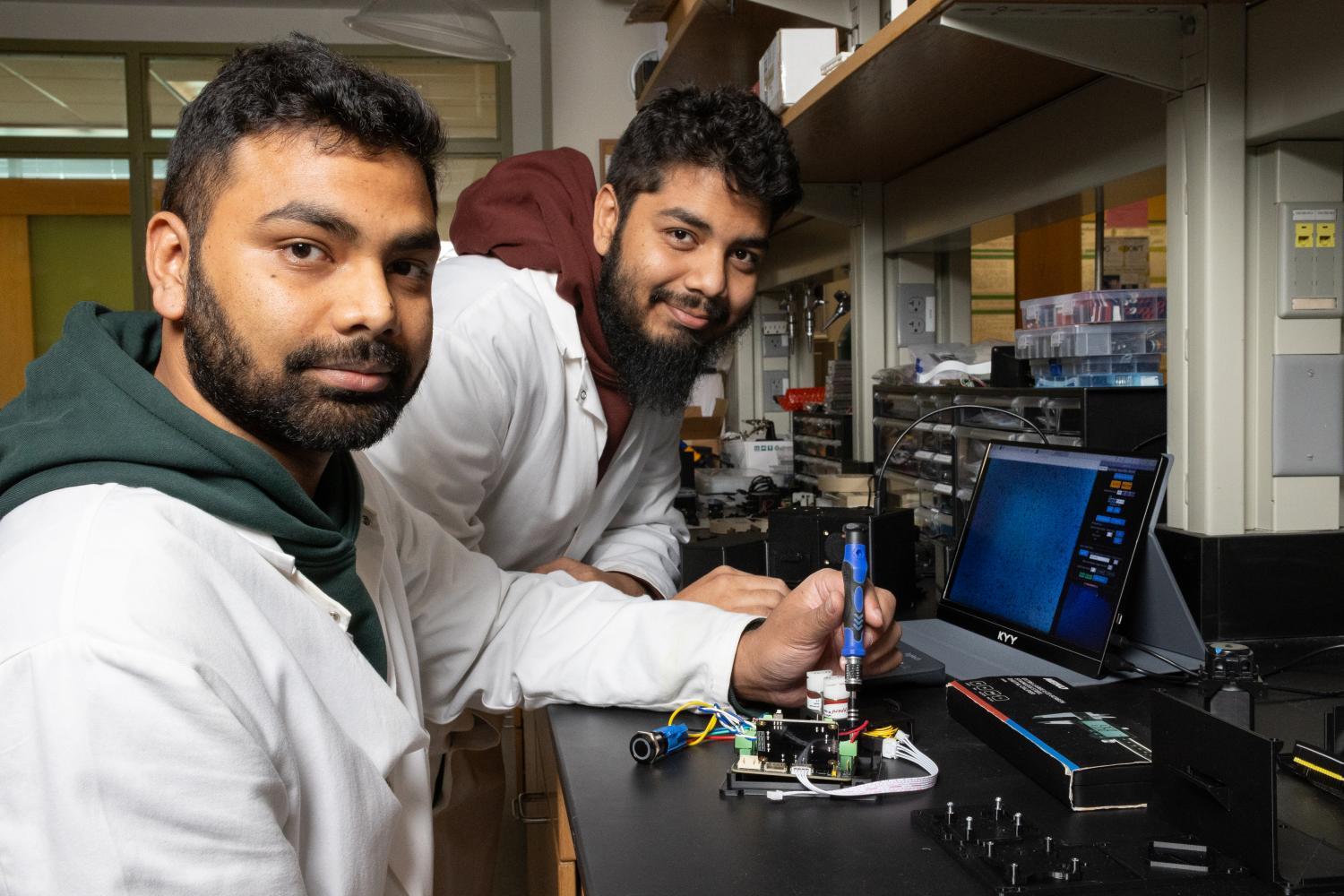
Environmental Engineering graduate students Farhan Khan and Farshid Khan are passionate about providing access to clean water.
They have a lot in common—starting with the fact that they are brothers. Farhan Khan came to Georgia Tech from Bangladesh to begin his Ph.D. studies in 2021. Farshid Khan followed in 2024, beginning his first semester assisting a doctoral student in the very same lab as his older brother.
“Georgia Tech undoubtedly has one of the best programs in this field,” Farshid Khan said. “Also because of the fact that my brother is here, when I got the admission offer, it was the perfect place to come.”
Their journey to Georgia Tech is deeply rooted in their experience growing up in Bangladesh.
“One of the major problems in Bangladesh is textile effluent pollution,” Farshid Khan said. “It is one of the largest textile exporters in the world. But the problem with the textile industry is they do not treat the water well. All of their effluents come into our rivers and they are highly polluted.
“I always wanted to work on that, and it is still my plan after going back to Bangladesh to work on that.”
Read more about their story on the School of Civil and Environmental Engineering website.
Melissa Fralick
